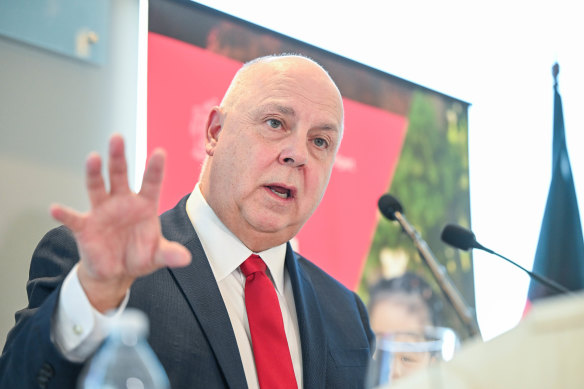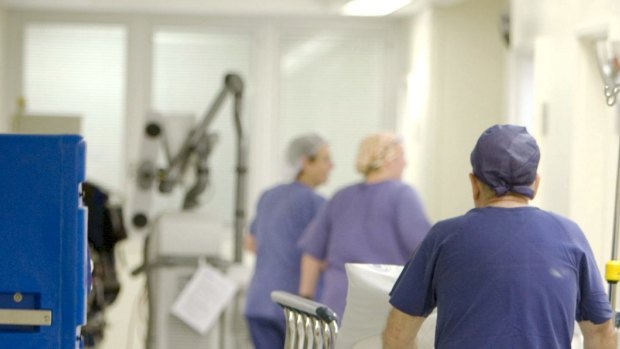- Exclusive
- National
- Victoria
- Victorian budget
Sweeping hospital mergers on table after Victoria’s bad-news budget
By Aisha Dow, Annika Smethurst and Kieran Rooney
Victoria’s hospitals face being amalgamated into large networks under sweeping mergers of local services in an efficiency-driven overhaul of the public health system, revealed as the government dropped a bad-news budget featuring soaring debt, stalled major projects and abandoned promises.
Treasurer Tim Pallas said his 10th budget would help families, but the only sweetener was payments of $400 per child from next year for the families of students in Victorian public schools and concession cardholders at non-government schools.

Treasurer Tim Pallas dropped a bad-news budget on Tuesday.Credit: Joe Armao
Victoria’s net debt is forecast to hit $187.8 billion by June 2028, leaving taxpayers with a daily interest bill of $25 million. Rating agency S&P Global said the debt pile was set to “soar” compared with the government’s revenue, while Moody’s said interest payments would “significantly constrain” the state’s ability to spend.
Pallas said the budget was focused on fiscal discipline and “making sensible decisions that respond to the challenges that confront us and that lie ahead”.
The attempt to curb spending will result in delays to transport, school and health projects, the rollout of government-funded preschool will be delayed for four years amid a shortage of workers and pressure on construction, and Melbourne Airport Rail is now on ice for twice as long as expected.
Following the budget, two health sources and an industry source – speaking anonymously because they were not authorised to talk publicly – revealed the government’s health plan had been whittled down to two options, the most likely of which would result in a significant merger of health services.

The Victorian government’s health plan could involve merging health services across the state.Credit: Glen Hunt
A leaked document, seen by this masthead, reveals one of the options is mergers – or “consolidations” – which would mean many existing health services would lose their own chief executive and local boards and have them replaced by an advisory board.
One senior health source said they had heard advice that this option would mean Victoria’s 76 health services would be reduced to 12 – six in metropolitan Melbourne and six in regional Victoria.
Victoria’s 76 health services compares with 17 health districts in NSW, 16 in Queensland, 10 in South Australia and five in Western Australia.
The sources said there were fears regional patients could be forced to travel long distances for basic services, and that local jobs would be lost.
“There’s been a distinct lack of consultation,” said one source involved in discussions with the expert committee that is developing the plan.
A second, less likely option, would not be a major reform. Instead, “each health service remains an individual employer, with some shared arrangements”, according to the leaked document.
Victorian Healthcare Association chief executive Leigh Clarke said, “irrespective of the final design option, there will need to be greater investment into the system to support the change management requires to achieve large-scale reform”.
Rural Doctors Association of Victoria acting president Louise Manning said she was not opposed to amalgamations as long as country towns did not lose access to health services. However, she said there were concerns about senior jobs in small towns and whether they would be replaced by managers based in central locations, far from rural services.
Asked about the progress of the plan, a Victorian government spokesperson said they were awaiting the advice of the independent committee.
“Our health system – like health systems across Australia and around the world – is facing significant challenges due to the impacts of the COVID-19 pandemic. It is important we look at how the system is organised to ensure we are delivering the very best health care, closer to home for all Victorians wherever they live,” the spokesperson said.
Tuesday’s budget also revealed two planned medical towers at the Arden development precinct in North Melbourne would not go ahead due to electromagnetic interference from the new Metro Tunnel station. Existing facilities in Parkville will be expanded instead.
The state’s trial of sick pay for casual workers has been abandoned. Help for first home buyers will also be cut off in a year – a one-off $700 million supplement will tide the scheme over until a proposed federal government replacement is ready.
The government has also increased its tax take by hiking the waste and fire services levies.
Despite the tough economic decisions, Victoria’s debt will continue to rise, peaking at 25.2 per cent of gross state product by 2026-27. Net debt will rise from $156.2 billion by the end of the next financial year and hit $187.8 billion by June 2028.
Four months ago, the Treasury predicted the state’s net debt would hit $177.8 billion by mid-2027, but that forecast has been pushed up, with net debt now expected to reach $179.2 billion by the end of the 2026-27 financial year.
The Allan government is forecasting operating surpluses of $1.5 billion in 2025-26 leading into the 2026 state election, and $1.6 billion in 2026-27 – an improvement from the mid-year budget update.
Pallas said the budget considered the government’s two big problems – high inflation and workforce shortages – and “how best to manage both”. He said Australia was 229,000 workers short of what was needed for construction projects alone.
In an election backflip, the rollout of 30 free hours of pre-prep for four-year-olds will be delayed by four years and government-owned childcare centres will open years later than promised.
Pallas said: “The workforce shortage is hitting not only our construction projects, it’s also hitting our caring and our social sectors.
“We’re progressively returning the capital program to pre-COVID levels to better align with the ability of our economy to deliver, and to free up capacity in the private sector to build much more needed housing.”
Small projects across all government portfolios will be pushed back, but it will not affect the $26 billion North East Link or $35 billion Suburban Rail Loop East.
Pallas said the government needed to be realistic about the timeline for the Airport Rail, which was due by 2029.
“We’ve made the sensible decision to acknowledge the project is now at least four years delayed,” he said.
Hospitals, which are increasingly reporting major operating deficits, will receive an additional $8.8 billion over the next four years.
Government belt-tightening will also mean the sale of office space previously used to house public servants, and a delay to a program that offers treatment, care and support to Victorians aged over 26 with mental health issues.
But the government will inject a further $211 million to keep women and children safe, with new prevention programs designed to prevent violence.
Opposition Leader John Pesutto said the budget showed a series of broken promises and accused Labor of blaming COVID for “every failure”. “Labor’s 10th budget is proof that those who caused the problem cannot be relied upon or trusted to fix the problems,” he said.
The budget was tabled in state parliament on Tuesday as the Reserve Bank kept interest rates on hold at 4.35 per cent.
S&P said Victoria’s debt was due to large deficits incurred during the pandemic and significant spending on major projects.
While the agency affirmed its AA rating for Victoria, it said the ratio of debt to income for the state was the highest in Australia at 200 per cent, and the cost of servicing that debt was increasing as interest rates rose.
But S&P said Victoria still had strong access to global capital, which allowed it to fund its budget despite interest costs and more volatile financial markets.
“The state is partially shielded from rising interest rates in the immediate future because it mainly funds itself through fixed-rate, long-term borrowings,” the agency said.
John Manning, Moody’s vice president and senior credit officer, did not expect Victoria’s debt burden to stabilise before the end of the 2028 financial year, which would maintain negative pressure on the state’s rating.
“Debt affordability has continued to deteriorate with the state projecting interest payments to increase to 6.2 per cent of revenue by end June 2024 and will significantly constrain Victoria’s operating profile over time,” he said.
Before the budget, Pallas received a big windfall from Canberra, with an extra $3.7 billion from the Commonwealth in GST payments, but economists warned the government against baking in the new rate, based on Victoria’s comparative position against NSW and Queensland, which benefited from coal royalties and soaring land values.
Federal Treasurer Jim Chalmers will next week hand down the federal budget and Pallas used his economic statement to push for more assistance from Canberra.
He accused the Commonwealth of a long-term failure to adequately fund Victoria’s infrastructure. “Between 2014-15 and 2022-23 Victoria received $8.3 billion less than our population share of infrastructure funding,” Pallas said.
The state government also announced it would rein in funding to a controversial investment fund that uses taxpayers’ money to invest in start-ups and expanding businesses.
With Benjamin Preiss
Get the day’s breaking news, entertainment ideas and a long read to enjoy. Sign up to receive our Evening Edition newsletter here.